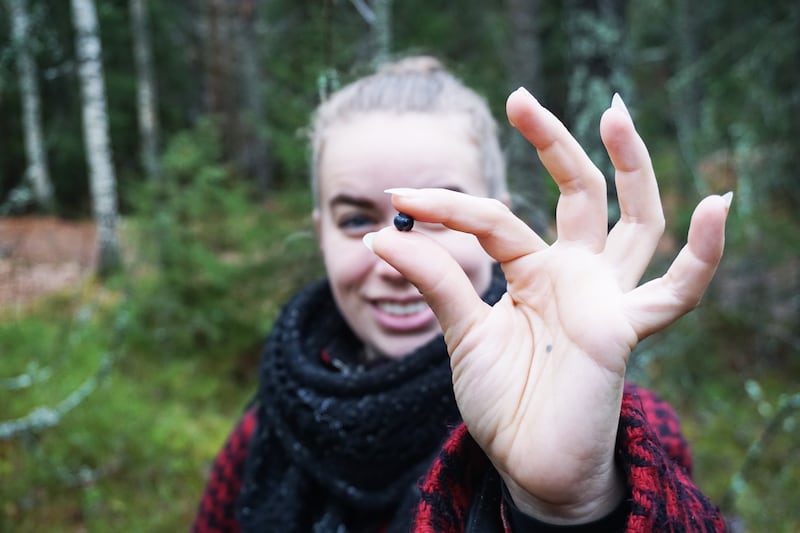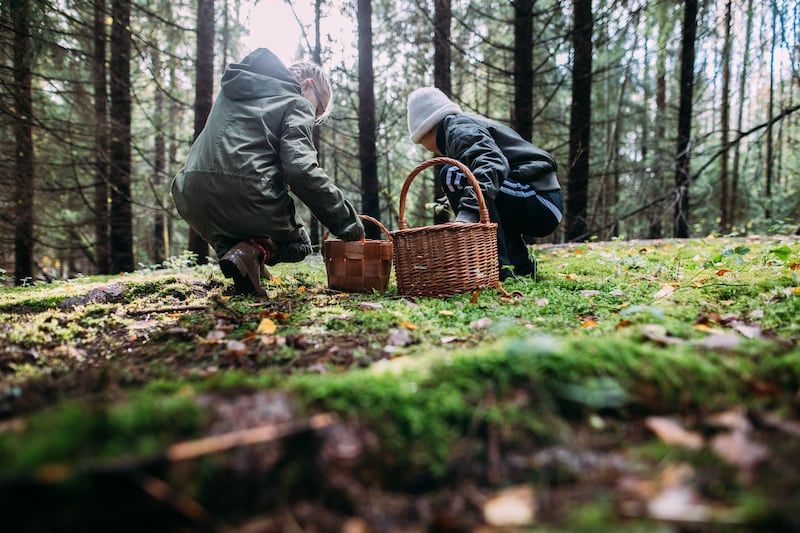In the icy fresh air of the Nuuksio National Park in Finland, dwarfed by towering pine trees that catch the day’s light rain before it reaches the forest floor, I listen intently to my foraging guide. Inu Pelli, a wilderness expert who’s been mushroom-picking since she was a child, is giving this group of first-time foragers a crash course in what we’ll find.
There are thousands of types of mushrooms in Finland’s forests, she tells us, but most are non-edible and some are poisonous enough that just one mushroom can kill you.
“So when you pick a mushroom, pick it all and don’t leave the root,” she advises. “That can be important to identify mushrooms from the Amanita family, the most poisonous mushroom. If there is a bulbous root, just leave it where it is.” And with that, we’re let loose to scour the ground for mushrooms that might either be delicious or deadly.
It takes me a few minutes to focus my “mushroom eyes”, but when I finally do, it’s miraculous how suddenly the whole ground seems clustered in all types: easily identifiable chanterelles, milk cups that are edible after boiling, poisonous ones that don’t make it into my basket, and the red-with-white-spots type made famous by Super Mario (also poisonous).
RM Block

Pelli explains that foraging is part of traditional Finnish culture — two-thirds of the country is covered with thick forests, rich with edible delights throughout the year such as mushrooms, berries, herbs and plants.
Partly to make the most of the free organic supermarket on their doorstep, but partly to spend time in nature — it’s forest bathing before that term existed — one in four Finns head out to forage. In fact, they top the world charts for it (and over the course of my few days in Helsinki, I learn that the idiosyncratic Finns top many comparative lists about contemporary living).
As traditional as foraging may be, it’s a sign of their comfort with modernity that Helsinki’s food scene stretches to be as inventive as its Scandinavian cousins in Copenhagen and Stockholm. And with a strong identity and discerning taste, the capital strikes out in its own direction. Their food markets are strong with Finnish produce, and their national love of sushi (as well as Japan in general) makes sense when you think about the abundance of fresh fish in the country.
Their contemporary restaurants are another case in point. Indeed, my next encounter with mushrooms is at Finnjävel, a pop-up turned Michelin-starred restaurant that uses traditional Finnish techniques such as curing, smoking and fermenting to form the basis of their contemporary menu.

Their owners, including head chef Tommi Tuominen, brought the restaurant into being with the audacious claim that it would only stick around for two years. When that time came, humble pie was duly served instead, and now they’ve set up a permanent home in a magnificent stone building from 1830, when the Russians ruled Finland. Finnjävel is found in a quiet corner of Helsinki’s south harbour area, past Oodi, Helsinki’s colossal library and social space that’s open for books, chats, wines, gaming, music production and more until 9pm (oh, for the quality of life in Helsinki).
The restaurant is divided into two parts: there’s a fine dining room of Salonki, and Sali, which they call the “relaxed restaurant experience” even if the interiors are all high-end Finnish, with sweeping material hung from the ceilings and a soft underlighting to add subtle drama. The dishes, such as the starter of mushroom porridge topped with pan-fried wild mushrooms, is delightfully detailed in its balance and textures — there’s the creamy, chewy and crunchy in one bite.
There’s a similar standard of fayre at Nolla, the country’s first zero-waste restaurant, and one that has sustainability built into its operations. In its upcycled, industrial-chic premises in the Punavuori neighbourhood, diners can see the vats of beers made using leftover yeast from the bread they serve.
Luka Balac, one of its three international owner-chefs, introduces me to state-of-the-art, no-smell composter affectionately known as Lauri. It sits in a corner of the restaurant, gobbling up waste like coffee grinds and fish bones — all weighed beforehand, to ensure food waste is being kept to a minimum. “It turns to compost within 24 hours, and we send it back to the farms to use, so we close the loop,” he explains.
We were disgusted by the amount of food wastage we’ve seen in some kitchens. And it’s disrespectful to the producer
“The starting point for all of this is that we grew up close to nature, and when you know the effort it takes to grow something, wasting it doesn’t make any sense,” he says. “We were disgusted by the amount of food wastage we’ve seen in some kitchens. And it’s disrespectful to the producer. And it doesn’t make financial sense, which is important when running a restaurant. So we saw a clear benefit to waste less.”
Their commitment to sustainability goes further: their ceiling lamps, for example, double up as acoustic panelling for extra efficiency, and they source their seasonal ingredients from small and local producers, refusing to accept anything that’s not in reusable or recycled packaging.
But is it a success as a restaurant? The proof is in the pudding — and the refreshing bay leaf ice cream (Finns are also Europe’s biggest ice cream eaters, would you believe) is convincing.
Across my long weekend of eating all around Helsinki, it quickly becomes clear just how robust the Finnish palette is. There’s the punchy dill garnished generously over tangy salmon dishes. The coffee that would blow your head off — it’s no surprise that they’re the world’s biggest coffee drinkers too. Even the local corner store where I buy my obligatory hotel room crisps sell black truffle crisps as standard. And akin to sausage rolls, the national grab-and-go snack, is a rye pastry topped with egg butter known as Karjalanpiirakka (a mouthful indeed).
As their culinary delights show, the Finns are far from a bland bunch
Nothing proves the Finn’s sophisticated tastes more than liquorice, my confectionery nemesis. A sucker for punishment if not salty sweets, I’m hoping that in the spiritual home of the other black stuff, we’ll finally come to a truce. For a taste test, I head to the Willy Wonka-esque shop of Roobertin Herkku, whose window is adorned with rows upon rows of liquorice jars among the American and international candy.
Guided by owner Arja Klskela, whose family have owned the sweet shop for three generations, I opt for the tar flavour because it’s traditional in Finland. As soon as I pop it into my mouth, it’s an immediate no — to my basic tastes, the gummy liquorice is heavy and unforgiving and makes my mouth want to curl inside out. I buy Jelly Bellys to take the taste away, pleased that at least I tried it. Just never again.
As their culinary delights show, the Finns are far from a bland bunch. They may indeed top charts for foraging, drinking coffee, eating ice creams (as well as for saunas per capita), but they also recently topped the UN’s World Happiness Report for the fifth time. So perhaps we might take a leaf from their book. And there’s no better place to begin than its famous forests.
Shilpa Ganatra was a guest of Helsinki Partners. Finnair fly direct from Dublin to Helsinki daily

















